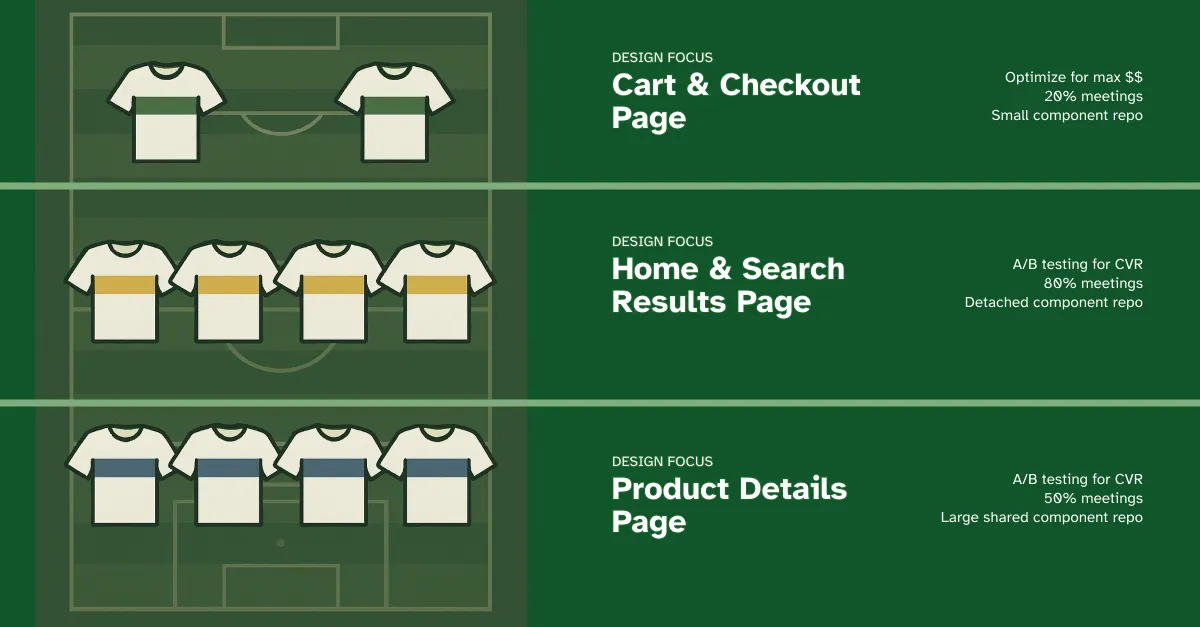
The Total UX Team
The problem with designers in siloed verticals
Traditional UX design often operates in silos. Designers are assigned to specific verticals or pages, becoming specialized in one small area of the product. This structure can lead to several issues:
Knowledge Gaps:
Siloed teams often reinvent the wheel. Lessons learned in one area don’t easily transfer to others, resulting in duplicated efforts and missed opportunities for reuse or alignment.
Reduced Agility:
When each designer is tied to a specific vertical, shifting priorities can create bottlenecks. Teams lose the ability to quickly reallocate resources, slowing down progress and responsiveness to change.
Limited Growth:
Designers stuck in narrow scopes—like endless A/B tests or UI tweaks—often feel their creativity stagnate. Without new challenges, professional growth slows, and motivation dips.
Tunnel Vision:
When focused on a single slice of the product, designers miss the bigger picture. This isolation makes it harder to understand how their work fits into the full user journey—or impacts adjacent experiences.
Burnout:
Repetition without variation can wear anyone down. Working in silos not only limits excitement but also erodes long-term engagement and satisfaction.
Example: Siloed Team Structure

The Total “Football” Team Paradigm
It’s fascinating how real-world systems can mirror effective team dynamics! While reflecting on my own UX team’s structure, I recently discovered a striking parallel with “Total Football”, the revolutionary approach of the Dutch national team in the 1970s.
For years, my teams have operated with a fluid, adaptive structure, much like the players, playing in the “Total Football” system. Designers seamlessly move between projects and tasks, unrestricted by rigid specializations. It’s been our natural mode of operation, and it’s yielded some fantastic results.
Here’s how we do it:
Shared Ownership:
Work flows into the team through a shared intake process. Together, we groom, discuss, and prioritize tasks—ensuring everyone has the full context. Once ready, any designer can pick up any task, regardless of the product area. There are no “assigned” verticals—just collective responsibility and trust in each other’s versatility.
Collaboration:
We run short daily stand-ups where designers from different pods briefly share what they’re working on, any blockers, and what they learned recently. These micro-updates often spark spontaneous support across verticals. Our weekly feedback sessions double as design reviews—creating space to zoom out, share context, and cross-pollinate ideas.
Fluid Movement:
Designers are encouraged to move between projects and tasks, gaining exposure to different areas of the product and different design challenges. For example, a designer working on onboarding might jump into a growth initiative one sprint later. This not only helps prevent stagnation but also brings fresh insights into both experiences. Designers self-select based on interest, bandwidth, and learning goals, which boosts both ownership and variety.
This “Pod” or “Total Football” system approach to design team operation, has fostered a collaborative environment where knowledge sharing is ingrained in our process. It’s allowed us to break down silos, encourage cross vertical understanding, and ultimately deliver better user experiences.
The rise of AI is changing how we approach design expertise. Instead of relying solely on embedded SMEs (subject matter experts), AI tools can now provide on-demand insights—from past experiments to user research highlights. This unlocks a key benefit of the Total Football model: designers don’t need to be permanent specialists to make smart decisions—they just need access to the right context at the right time.
Deeply Understanding User Needs: Conducting thorough user research and articulating user problems with clarity. Crafting Holistic Solutions: Designing solutions that address user needs across the entire product ecosystem. Working as a Unified Team: Collaborating effectively to deliver exceptional user experiences.
In today’s dynamic environment, UX teams need to be agile and adaptable. The “Total Football” approach empowers designers to break free from silos, embrace collaboration, and focus on solving user problems. By fostering a culture of shared ownership and continuous learning, we can create high-performing teams that deliver exceptional user experiences.
It’s time to rethink the traditional UX team structure and embrace the power of the “Total Design Team.”